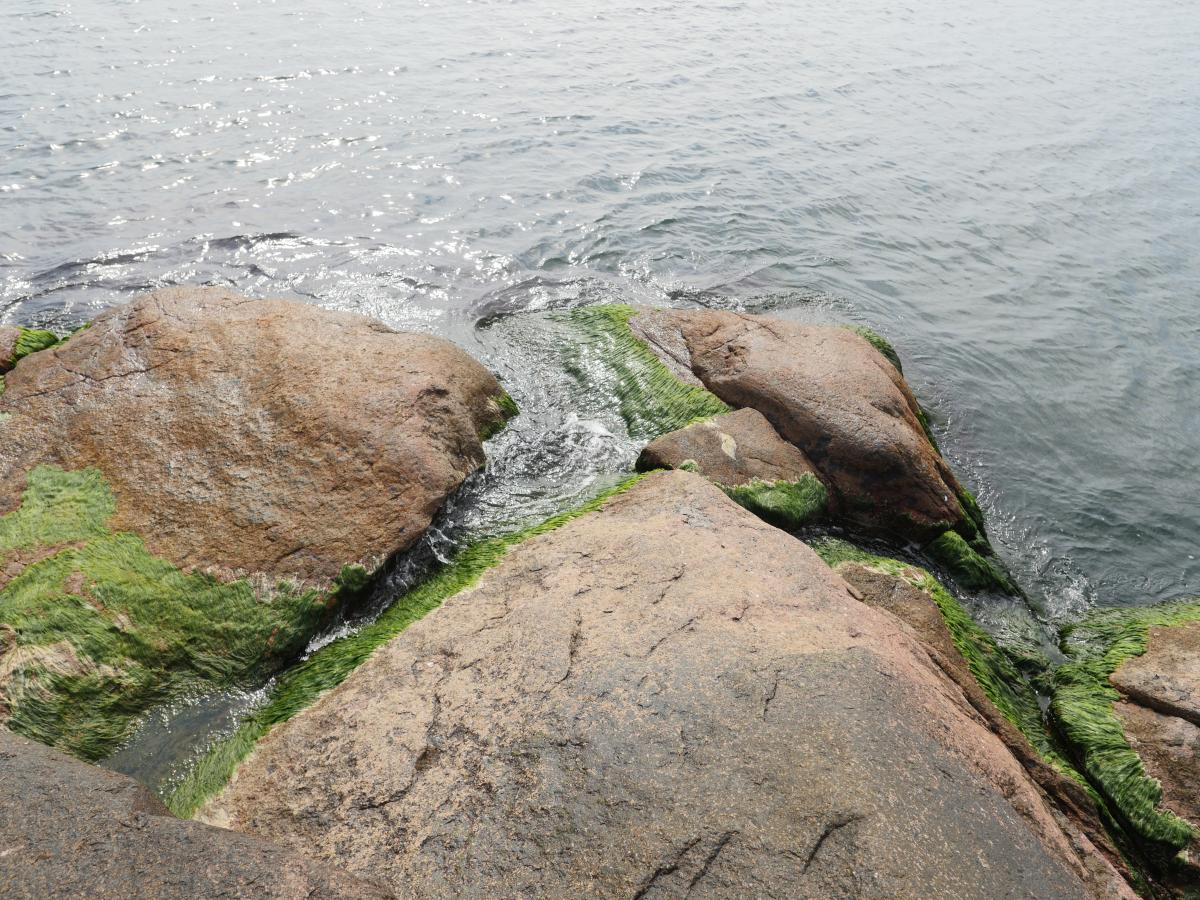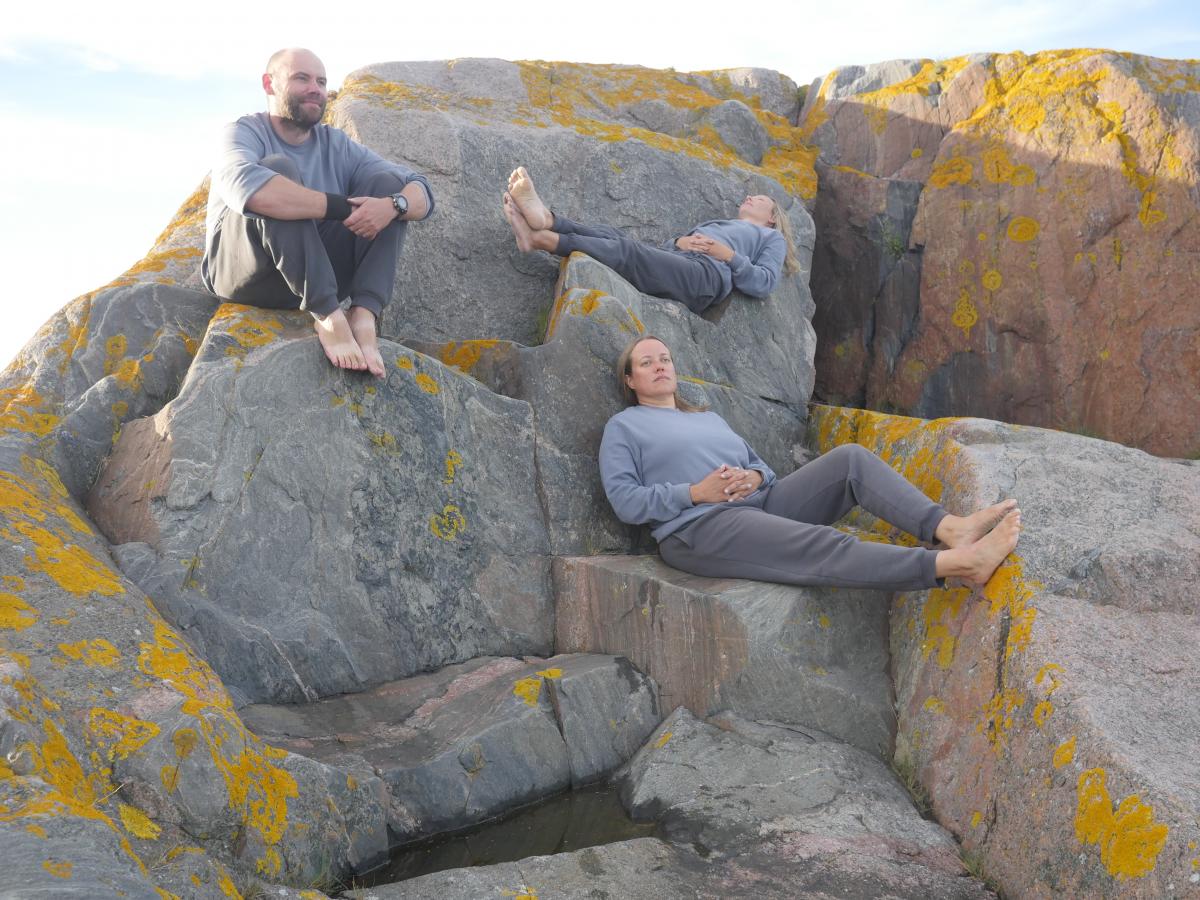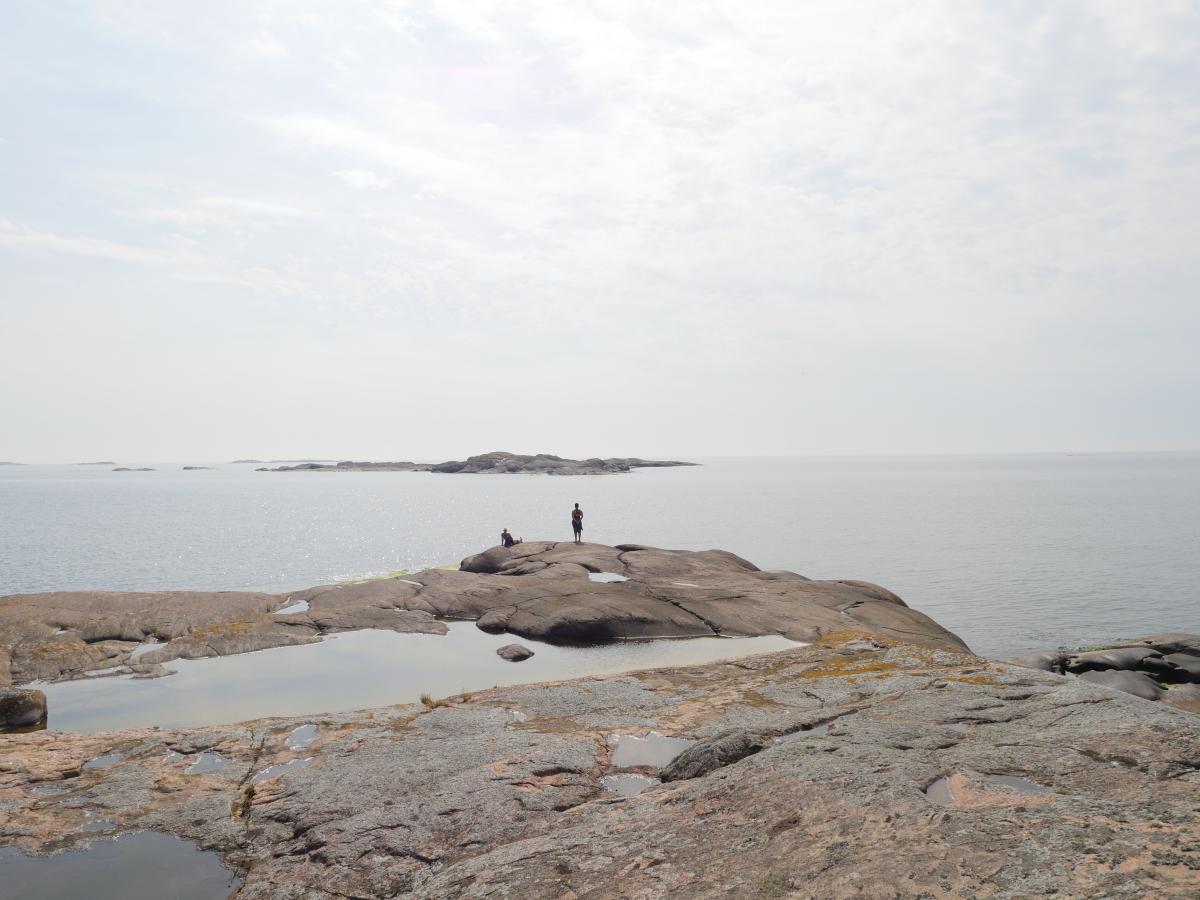How to Approach an Islet?
Leena Kela presents methods for coping with the present environmental destruction of the Baltic Sea and beyond.
Leena Kela
An islet is a small island, often unnamed and sometimes even invisible to the eye, since some of the underwater rocks can also be called islets. Islets are barren islands with no vegetation or at most growing some moss, grass or other small plants. There are tens of thousands of these tips of rock peeking out from the Baltic Sea at the Finnish archipelago.

In 2020 I formed a collective together with artists Heini Aho and Eero Yli-Vakkuri, which we named The Institute for Coping with Destruction. Our collective works at the Archipelago Sea near the island of Örö. The Institute for Coping with Destruction exists as a physical site called Tuhon tila (Area of Destruction), which consists of 42 hectares of land formed by almost as 300 islands, islets and underwater rocks the collective co-owns with many others. Co-ownership gives us rights to camp, make fire and use the islets for making art, but not to insert any permanent buildings there. By physically working at the Area of Destruction we are devising methods for coping with the present environmental destruction of the Baltic Sea and beyond.
How to practice coping with destruction instead of fighting against it?
The Baltic Sea, as one of the most polluted seas in the world, has many unique and inspiring properties to examine the concept of destruction. For example, some parts of its basin are considered dead as a result of lack of oxygen and surplus of nutrients, which centuries of farming admissions on the shores of the shallow sea have caused. [1] Destruction inhabits the sea, and our institute is seeking ways to embrace it instead of fighting against it. By living within destruction, by finding ways to cope with it, we also meet the ecological crisis as a call to adapt and to change ourselves.
“The machine is tired and exhausted” said philosopher Bayo Akomolafe in 2020 in a podcast series For the Wild when talking about the times of catastrophe and crisis. [2] Time of crisis is accelerating. A body is getting tired and exhausted. We are facing one storm after another. We are fighting climate change and trying to defeat it. We are falling into despair and losing energy.
In the Institute for Coping with Destruction we have been practicing deep adaptation [3] by challenging and overcoming physical limits of our bodies, by learning new marine skills and by practicing for example trembling, growling and sea water tasting. The next step is to learn to rest.

In August 2022 we worked a month at the Öres residency, during which we engaged with our remote islets by swimming and rowing to them. At the beginning of the month-long residency, we hadn’t access to a rowing boat, so the only way to approach the islets was by swimming. The vastness of the sea landscape distorts the shapes of islands and islets, and it is challenging to estimate distances at sea. When arriving at a designated islet it might suddenly look alien, and you can’t be sure if this was the one that was originally spotted as a destination. Swimming in the open sea is both a physical and mental exercise. You need to prepare well to be able to swim long distances. The sea temperature at the Archipelago Sea in August was 20 Celsius degrees, so it was relatively good for swimming. Still, when swimming long distances in open water without a wetsuit, there is a risk for a muscle cramp. We were wearing life jackets and carried with us in a waterproof bag a towel, a light jacket, drinking water and a mobile phone for emergency situations. None of us got serious muscle cramps, but swimming amongst the large flocks of common jellyfish made us sometimes yarn for the wetsuits.
The shores of both the island of Örö where we departed from and the islets, we arrived at were sharp and slippery, covered with algae. By the islet there might be big underwater stones covered with bladder wrack, so there might be a risk of hitting your knee in a stone when landing and getting bruised and scratched. Landing on an islet by swimming is like asking for permission to approach another. You need to look for a spot which looks least rough. A spot where the waves are not hitting the rock too hard, because they might push your body onto the rocks too forcefully and cause damage. You need to look for a gently sloping spot where you can slide your body onto the rock like a seal or crawl on all four like a frog. When landing you need to be aware, present and curious.
How does gathering become a “happening”, that is greater than a sum of its parts? One answer is contamination. We are contaminated by our encounters; they change who we are as we make way for others. As contamination changes world-making projects, mutual worlds –and new directions– may emerge. [4]

Getting to know the islet is the next step. Already the aspect that after arriving at the islet by swimming, you are most probably walking barefoot, and the soles of your feet provide a lot of information on the shape, surface, temperature, and possible flora of the islet. The main visible inhabitants of the islets are birds. Most visible are seagulls, terns, and great cormorants, which have left their excrement in formations of white marks on the rocks. The sizes of the islets vary from very small to quite large, so exploring an islet is always an adventure. Something that might look like a piece of rock from a distance, consists of different shapes, structures, and details. Due to the nature of the islets, them being so many, remote and without any utilization purposes, people very rarely visit them. Still they are full of human traces carried there by the sea: toothbrushes, food packages, ropes, nets, canisters, and many others. Human traces are everywhere, because the sea water is a vast rubbish dump moving the disposed objects and microplastics within its flows.
We are learning to rest in the eye of a storm
The destruction of the Baltic Sea is often not visible for the bare eye examining the sea from above the surface. The troubles the Baltic Sea is facing might not even be visible when diving into the sea, since we might not have a capacity to recognize them. How to work with environmental destruction when it can’t be presented in a visible form or it can’t be experienced with bare human senses, but rather needs to be imagined based on scientific facts and knowledge? How to build relationships to the complex topic of environmental destruction and its multiple entanglements to the questions of lives of other species, of futures, of economy, of justice and of our own existence? How to slow down, think complex thoughts and face the destruction, when its emotional burden is so heavy that it might break you down?

Is there space for resting within destruction? Slowing down as a method for coping with destruction changes the experience of time. Slowing down doesn’t only refer to the function of speed, but to awareness. [5] Slowing down is to learn to be present where you are and what you are doing. It means not accepting to be a machine, but to be present and through that acknowledge the others who are here with you, to acknowledge those entanglements to past, present and futures which we share with other humans and more-than-humans.
What is then resting? Resting is to resist a capitalist sense of productivity and the notion of endless progress. [6] Resting is to reconnect. When resting instead of fighting one is in the process of adapting, coming to terms with the climate catastrophe as a condition we are living in – amongst other crises – instead of trying to escape. Resting is to stay with the trouble. To be present and learn to adapt. Resting is not to become passive, to turn your back on something you are not willing to participate in, but resting is an active form of resistance.
Islets are oasis for resting within the destruction. They are solid grounds in the middle of the constantly moving seas. They are places to recover from burn outs caused by the accelerating destruction. They are places for dreaming when reality offers nightmares. Islets are small islands for embracing hope.

Notes
- Jokinen, S. A., Virtasalo, J. J., Jilbert, T., Kaiser, J., Dellwig, O., Arz, H. W., Hänninen, J., Arppe, L., Collander, M., and Saarinen, T. 2018. A 1500-year multiproxy record of coastal hypoxia from the northern Baltic Sea indicates unprecedented deoxygenation over the 20th century. Biogeosciences, 15, 3975–4001 https://doi.org/10.5194/bg-15-3975-2018
- Dr. Bayo Akomolafe on Slowing Down in Urgent Times. 2020. For the Wild podcast series episode 155.https://forthewild.world/listen/bayo-akomolafe-on-slowing-down-in-urgent-times-155
- Bendell, Jem. 2018. Deep Adaptation: A Map for Navigating Climate Tragedy. University of Cumbria. https://www.lifeworth.com/deepadaptation.pdf
- Tsing, Anna Lowenhaupt. 2015. Art of Noticing. The Mushroom at the End of the World. On the Possibility of Life in Capitalist Ruins. Princeton and Oxford: Princeton University Press. (page 27)
- Dr. Bayo Akomolafe on Slowing Down in Urgent Times (2020). For the Wild podcast series episode 155.ttps://forthewild.world/listen/bayo-akomolafe-on-slowing-down-in-urgent-times-155
- Crary, Jonathan. 2013. 24/7: Late Capitalism and the Ends of Sleep. London and New York: Verso. (pages 9-11)
Bibliography
- Bendell, Jem. 2018. Deep Adaptation: A Map for Navigating Climate Tragedy. University of Cumbria. https://www.lifeworth.com/deepadaptation.pdf
- Crary, Jonathan. 2013. 24/7: Late Capitalism and the Ends of Sleep. London and New York: Verso.
- Jokinen, S. A., Virtasalo, J. J., Jilbert, T., Kaiser, J., Dellwig, O., Arz, H. W., Hänninen, J., Arppe, L., Collander, M., and Saarinen, T. 2018. A 1500-year multiproxy record of coastal hypoxia from the northern Baltic Sea indicates unprecedented deoxygenation over the 20th century. Biogeosciences, 15, 3975–4001 https://doi.org/10.5194/bg-15-3975-2018
- Tsing, Anna Lowenhaupt. 2015. Art of Noticing. The Mushroom at the End of the World. On the Possibility of Life in Capitalist Ruins. Princeton and Oxford: Princeton University Press.
Podcasts
Dr. Bayo Akomolafe on Slowing Down in Urgent Times. 2020. For the Wild podcast series episode 155.https://forthewild.world/listen/bayo-akomolafe-on-slowing-down-in-urgent-times-155
Artist Bio: Leena Kela is a performance artist, a doctoral candidate at the Academy of Fine Arts of the University of the Arts Helsinki, artistic director of the New Performance Turku Biennale and a director of the Saari Residence. In her works and research, she explores dialogue between corporeality and materiality in performance art. She makes performances that play with and twist our relationship with everyday objects, perceptions and phenomena. She has presented her performances internationally at performance art festivals, events and exhibitions on every continent except Antarctica. www.leenakela.com
The Institute for Coping with Destruction: www.tuho.org
Ecological Thinking
This is the course blog for K-JI-11-23A – Ecological Thinking. In 2023-24, we explore “Vertical Ecologies” by visual arts, film and performance. The course is co-organized by Giovanna Esposito Yussif and Samir Bhowmik. Previously, in 2022-23, we organized a year-long collaborative research studio with Aarhus University, DK, Research Pavilion 2023 and Helsinki Biennial 2023 on the themes of environmental data, sensing and contamination.
Header image credit: Abelardo Gil-Fournier and Jussi Parikka / Seed, Image, Ground (2020)- With permission from the authors.
Latest posts
-
Ecocidal Development and Atmospheric Warfare - Guest Lecture by David Muñoz Alcántara, 18.3.
-
"Schizophrenic relationship with nature" - Guest Lecture by Matti Aikio, 12.2.
Follow blog